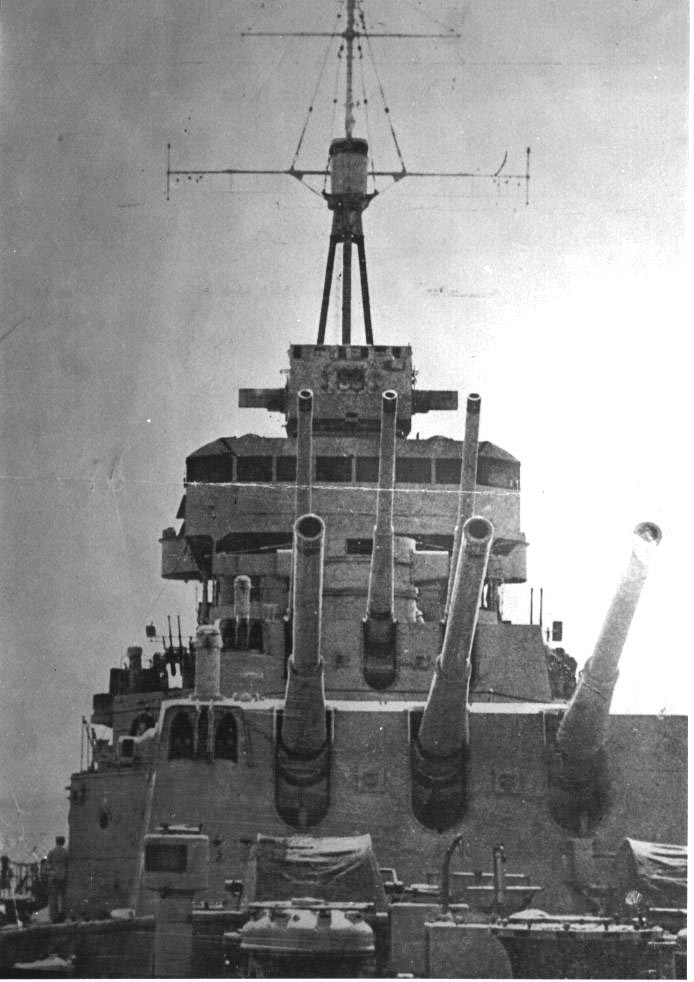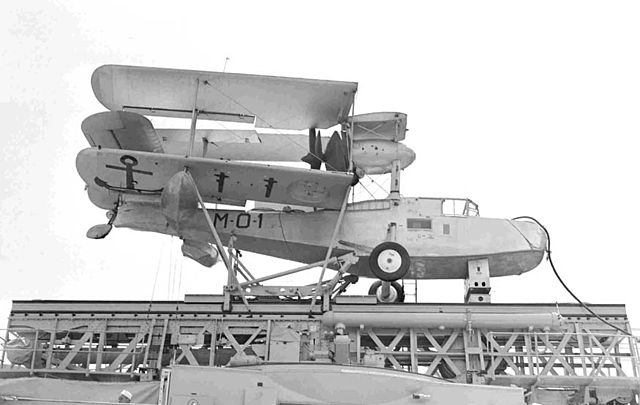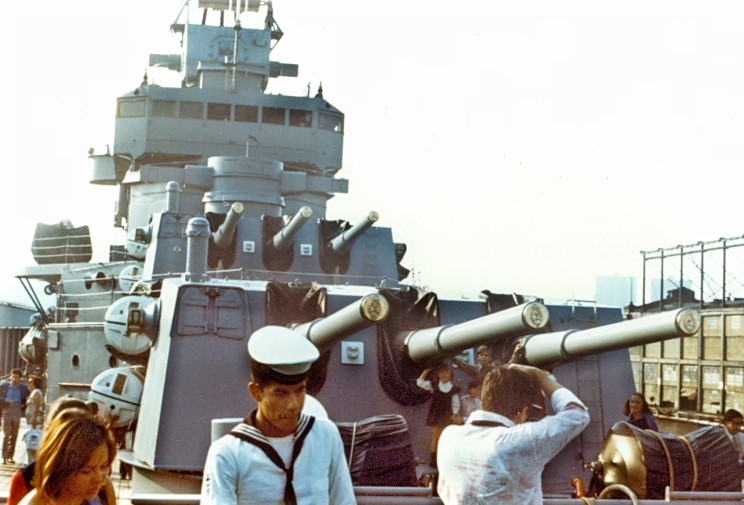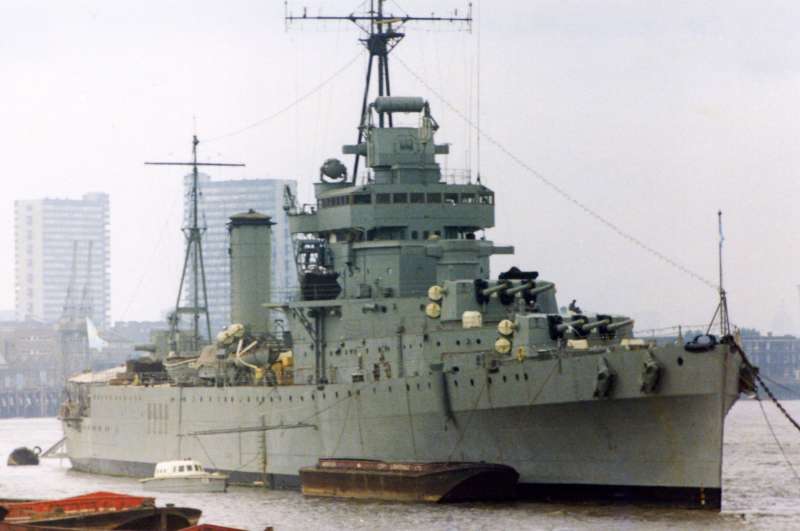The Argentinian school cruiser:
The cruiser “La Argentina”, was conceived as a training ship of the Argentine Navy and a command ship at the same time, built at Vickers-Armstrong, Barrow, between 1935 and 1937, but she did not take service until February 1939. She was modeled after light cruisers of the Arethusa class, but modified to have three additional 152 mm guns in triple turrets. The design of her bridge was also very different, but meeting the specific requirements of La Argentina. Replacing the old tall ship Presidente Sarmiento, she was retired from service in 1974.

La Argentina off Argentina, date unknown – from Tumblr via pinterest.
A history of Argentinian Cruisers
The story of this kind of ship in service with Argentina went back to the XIXth century, with the Patagonia (1885), Veinticinco de Mayo (1890), Nueve de Julio (1892), Buenos Aires (1895) and the might Garibaldi class Italian built armored cruisers. However WW1 has passed in the 1930s most of these cruisers were desperatey obsolete, discarded in 1930-34. The only exception were the Garibaldi class Belgrano and Puyrredon. Dating back 1897 they were modernized, converted to oil-firing and still served as TS. Therefore, it was urgent at that stage, in 1925 already, to plan for modern cruisers, after a gap of 30 years, filled with the Rivadvia class battleships, which were at that point the most modern and potent ships in the Navy. As dreadnoughts, they can’t be escorted by slower 1890s generation of protected and armoured cruisers Argentina possessed.
The first modern class of cruisers were the new Veinticicno de Mayo class, ordered in Italy. They were “quasi heavy cruisers”, with slightly smaller guns than 8-in and 9,000 tons fully loaded in displacement. To man them, the country needed a solid training ship, which also can perform standard cruiser duties and be used as a command ship. This led to the requirement for the La Argentina.
Development of La Argentina

Conway’s line drawing
The cruiser ARA Argentina was born in response to the requirement of a really modern school ship, similar to the cruisers the future Argentine officers would meet. It was supposed to replace the only ship in use for instruction on offer at that time, the old armoured cruiser ARA Pueyrredón alongside the frigate Presidente Sarmiento. The successful experience of the ARA Admiral Brown led the government to repeat a tender cross Europe, but specifically the conversion of a local model, but according to its own requirements to stay on budget.
Italy was soon eliminated (having offered already a derivative of its Trento class cruisers – Ventincinco de Mayo) and Great Britain, whose shipyards were already contracted to deloved 7 destroyers to argentina was soon the most serious condender. The ship was planned in 1933 and authorized in 1934, with a bid offered to international competition the next year. Proposals were received from British yards and was won by the British company Vickers-Armstrongs at a cost of 6 million pesos or £ 117,462.
Design
Structurally, the ARA Argentina was a modified Arethusa class cruiser. The British 5,000 tons light cruisers were armed with six 152 mm guns. However the Argentine cruiser was to be much heavier (7500 tons at full load) and longer (165 meters in length) for extra accomodations – the 60 cadets and their officers – than the original Arethusa. This cruisers offered overall a better habitability however due to her dual nature, school facilities were small in comparison to other contemporary school cruisers. Modification made the delivery of blueprints longer and costier, alongside a delayed final equipment delivery until January 31, 1939, as a result of the on-going British rearmament program. The Argentine cruiser was launched on 16 March 1937 in Barrow-in-Furness but only completed on 12 April 1939.
Armour
The levels of protection were similar: 3 inches or 76 mm. on the belt, conning tower walls, 2.5 in or 51 mm on the CT roof and turrets, and protective deck. The only advantage of this ship facing destroyers was its firepower, range and rapid-fire capability to keep any at a distance. Against other cruisers, speed was the only possible answer, but this was lacking in comparison to the Arethusa, much faster.

Armament
The main armament of the new cruiser was compatible with arsenals references of the Argentine fleet, which was, like the Chileans and Brazilians, largely supplied by the United Kingdom since the 1880s. The armament was superior compared to the Arethusa, as instead of twin turrets, triple ones were chosen, in the same configuration of two forward, one aft. This turret model was a modified version of the ones used on the Southampton class. These contained 6-inch/L50 (15.2 cm) semi-automatic type Mark V cannons. They were custom-made by Vickers-Armstrongs.
It also included four dual purpose 101/50 mm guns in simple mounts 4″/L50 (10.2 cm) Mark P. Like the main guns they were variations of standard British weaponry of the time.
This was to be completed by a full battery (confusion in some sources with postwar rearmament) of eight single 2-pounder “pom pom”.
In the 1950s, this was modernized to fourteen guns (four twin, six single) 40 mm Bofors and twelve 25 mm anti-aircraft heavy machine guns.
In addition to their typical triple banks or torpedo tubes either side of 21 inches or 553 mm, these cruisers had facilities necessary to operate two Supermarine Sea Gull seaplanes. However they were soon replaced by models which integrated the cruisers Almirante Brown and V. de Mayo, and supermarine Walrus. They were installed on a catapult at the rear between the two funnels.

La Argentina (C-3) off the Panama Canal, 2 May 1940.
Powerplant
The machinery of La Argentina was compromised in size as her primary function was to be a cadet ship prior to be a classic cruiser. Therefore machinery comprised four shaft Parsons geared turbines fed by 4 Yarrow type boilers rated for a total of 54,000 hp (40,000 kW), on three propellers, compared to four parsons turbines, four Admiralty 3-drum boilers on four shafts rated for 64,000 shp (48,000 kW) for the Arethusa. Coupled with the increase in displacement, La Argentina was three knots slower than the Arethusa. On trials, the Argentine cruiser reached 30’5 knots. At 20 knots, she however was capable of a range of 15,000 kilometers, quite a respectable figure, whereas the Arethusa were only capable of 5,300 nmi (9,800 km; 6,100 mi) at 13 kn (24 km/h), carrying 1,325 tons fuel oil. This suited the role of this school cruiser, making long cruises overseas, visiting ports and showing the flag around the world.

⚙ specifications |
|
| Displacement | 6,500 t standard, 7,500 t FL |
| Dimensions | 165 x 17,22 x 5,03 m |
| Propulsion | 4 shafts Parsons steam turbines, 4 Yarrow boilers 54 000 shp |
| Speed | 30 kts |
| Range | 12,000 nm/12 kts |
| Armament | 3×3 6-in/152 mm, 4×1 4-in/102 mm, 2×4 QF 2pdr AA, 2×3 21-in TTs |
| Protection | 76 mm belt, 51 mm turrets, see notes |
| Crew | 800 (and 60 cadets) |
| Aviation | 1x Supermarine Walrus |
Active life

La Argentina in 1939
For many, The La Argentina was the best and most balanced Argentinian cruiser ever in service, but she lived a peaceful existence as a cadet training ship and ambassador of the country she represented through her name on all seas. ARA La Argentina was delivered on January 31, 1939, but only joined her home port in March 1939 where she was commissioned. She was to serve for another Thirty-five years as an instruction vessel, but with her full combat capability, never neglected and carefully updated. Aftre the war she became the first Argentinian ship to receive a navigation radar, a Marconi model placed on a tripod mainmast in 1946.
Later in 1949 she enjoyed a radical upgrade of her anti-aircraft armament in 1949. The four single 101 mm dual purpose guns were replaced by four twin 40 mm mounts, six single mounts, and several 25 mm machine guns (up to 14). In the 1950s sensors were much improved. The La Argentina received a modern CIC, a Raytheon Pathfinder radar surface discovery radar and a modern Mk.8 fire director for her main artillery.
Organically, La Argentina did not operated alongside the two other Argentinian crisers, 21 of May and Admiral Brown or the Rivadvia class battleships. She was independent in that regard, but would have been used alongside these in case of war. In the 1960s she was however coupled along with the Brooklyn class cruisers in the so-called Argentinian “Cruiser Division”. She was recoignised indeed more valuable in combat compared to the Italian cruisers, which were discarded sooner.
She received the numeral C3, whereas the Italian-built cruisers were named C1 and C2. La Argentina allowed the Argentinian Navy to form three naval groups, each comprising a cruiser and four destroyers, the 12 modern units manufactured in Spain and Great Britain which were obtained 1928 and 1938. The battleships stayed as a home reserve in case, and guaranteed in case of war Argentinian dominance over the South Atlantic if it not had not been for the shortage of fuel.
Wartime Scenarios
Always in wartime scenarios, thanks to her great autonomy however, La Argentina was to act as a corsair, like the German ‘pocket battleships’ Graf Spee, Scheer and Lutzow. Admiral Brown and 21 May emulated on their side the Gneisenau and Scharnhorst, raiding enemy trade while staying out of harm from heavier ships. Meawnhile the task of Moreno and Rivadavia was to deter the intervention of enghbouring navies, and were superior to the Brazilians Minas Gerais class but would have been more in difficulty with the single Chilean Latorre, compensated by their numerical superiority and better protection overall.

Career
Arrived in Buenos Aires on March 2, La Argentina entered service on April 12, 1939 and three days later made his first training trip via New York to Europe, Hamburg and back home via Cádiz. She entered Puerto Belgrano on August 14. When World War II broke out, the new cruiser started in March 30, 1940, a second training trip across Bahia, the Panama Canal and Honolulu, up to Japan. With her back journey she passed through Manila and Hawaii, then off Callao, South American west coast, the Magellan strait, and its home port on 26 October 1940. She then started a new role in an active operational squadron making neutrality patrols which lasted until May 1945. After the war, she resumed her training trips until 1951.
In 1946, La Argentina made her first postwar training cruise along the American coast, up to Montreal and back. 1947 trip was again in the Pacific and through the Panama Canal, via New York and to Europe, visiting London and Malta. The 1948 trip was again in the Pacific, and she visited Shanghai, caught in the Civil war. She then visited Singapore, Colombo and Aden, all British bases, passsed the Suez canal to reach the Mediterranean, and visiting Barcelona on her way back westwards. For the first time an Argentine cruiser completed a circumnavigation. In 1949, she toured again Pacific side of South America, transited through the Panama Canal to visit New Orleans and from there departed to Europe, visiting London and Naples. The 1950 trip saw her sailing directly to Europe, visiting Copenhagen and she went back home via New York.

In between, the war has ended, so UK was able to deliver her promised material to modernized the ship. In 1946 she received her first radar as said before and three years later her AA was modernized, and this came wirh a new fire control system. Onboard airplanes were elminated. From 1951 to 1960, La Argentina limited her trips abroad. She made one in the fall of 1960 to participate in a large fleet parade in honor of the Portuguese 500th anniversary of the death of Henry the Navigator off Sagres. This was attended by 29 ships from 14 nations.

La Argentina in New York, open deck to the public in 1972. This was one of her last trips. Src Maritimequest
From 1961, she cruiser resumed her training trips; and made her second circumnavigation since 1948. She visited Cape Town, Colombo, Manila, Sydney, Wellington, Papeete, Talcahuano and Punta Arenas, and back to Buenos Aires after 139 days. Her ninth major training trip in 1961 was hampared by fiscal constraints. Instead she toured the west coast up to Vancouver and returned via Hawai and she visited Puerto Rico. In 1962 she was seconded by the new sailing training ship ARA Libertad. She made more modest yearly training trips along the Argentine coast the following years.
In 1971, La Argentina had 32 years of service already, making a 10th major training trip with the 100th Argentine Cadet Course from Buenos Aires via Montevideo, to Dakar, Casablanca, Naples, Barcelona, Le Havre and London. On her way back she visited Puerto Rico again, but also Santo Domingo, La Guaira and Bahia. In 1973, she made a state visit in Valparaíso to be visited by the Chilean president, Salvador Allende.

ARA La Argentina in Buenos Aires, circa 1972.
Retirement
La Argentina had spent her days touring the world. She was at least retired in 1974, already mothballed in 1973. Other light cruisers launched and delivered almost at the same time like the two Chilean Brooklyn, and even the Spanish Canary Islands were only retired in 1975, so slighlty later. Her continuous trips had worn their machinery out, despite careful maintenance. The cruiser was sorely lacking four years later, coupled with the ex-Brooklyn class Nine of July (retired 1977) for facing Chile in its quasi-war for the sovereignty of the Beagle Channel Islands. Also authorities or provate ventures failed at that time to preserve her, like HMS Belfast, as a floating museum on the Río de la Plata.
Read More:
Conway’s all the worlds fighting ships 1922-47
M.J. Whitley, Cruisers of World War Two, 1995, Arms and Armour Press
//en.wikipedia.org/wiki/ARA_La_Argentina_(C-3)
//www.histarmar.com.ar/Armada%20Argentina/HistoriaCrucerosArgentinos.htm
//www.argentina.gob.ar/armada
//de.wikipedia.org/wiki/La_Argentina_(Schiff,_1937)
//navypedia.org/ships/argentina/arg_cr_la_argentina.htm



 Latest Facebook Entry -
Latest Facebook Entry -  X(Tweeter) Naval Encyclopedia's deck archive
X(Tweeter) Naval Encyclopedia's deck archive Instagram (@navalencyc)
Instagram (@navalencyc)





 French Navy
French Navy Royal Navy
Royal Navy Russian Navy
Russian Navy Armada Espanola
Armada Espanola Austrian Navy
Austrian Navy K.u.K. Kriegsmarine
K.u.K. Kriegsmarine Dansk Marine
Dansk Marine Nautiko Hellenon
Nautiko Hellenon Koninklije Marine 1870
Koninklije Marine 1870 Marinha do Brasil
Marinha do Brasil Osmanlı Donanması
Osmanlı Donanması Marina Do Peru
Marina Do Peru Marinha do Portugal
Marinha do Portugal Regia Marina 1870
Regia Marina 1870 Nihhon Kaigun 1870
Nihhon Kaigun 1870 Preußische Marine 1870
Preußische Marine 1870 Russkiy Flot 1870
Russkiy Flot 1870 Svenska marinen
Svenska marinen Søværnet
Søværnet Union Navy
Union Navy Confederate Navy
Confederate Navy Armada de Argentina
Armada de Argentina Imperial Chinese Navy
Imperial Chinese Navy Marinha do Portugal
Marinha do Portugal Mexico
Mexico Kaiserliche Marine
Kaiserliche Marine 1898 US Navy
1898 US Navy Sovietskiy Flot
Sovietskiy Flot Royal Canadian Navy
Royal Canadian Navy Royal Australian Navy
Royal Australian Navy RNZN Fleet
RNZN Fleet Chinese Navy 1937
Chinese Navy 1937 Kriegsmarine
Kriegsmarine Chilean Navy
Chilean Navy Danish Navy
Danish Navy Finnish Navy
Finnish Navy Hellenic Navy
Hellenic Navy Polish Navy
Polish Navy Romanian Navy
Romanian Navy Turkish Navy
Turkish Navy Royal Yugoslav Navy
Royal Yugoslav Navy Royal Thai Navy
Royal Thai Navy Minor Navies
Minor Navies Albania
Albania Austria
Austria Belgium
Belgium Columbia
Columbia Costa Rica
Costa Rica Cuba
Cuba Czechoslovakia
Czechoslovakia Dominican Republic
Dominican Republic Haiti
Haiti Hungary
Hungary Honduras
Honduras Estonia
Estonia Iceland
Iceland Eire
Eire Equador
Equador Iran
Iran Iraq
Iraq Latvia
Latvia Liberia
Liberia Lithuania
Lithuania Mandchukuo
Mandchukuo Morocco
Morocco Nicaragua
Nicaragua Persia
Persia San Salvador
San Salvador Sarawak
Sarawak Uruguay
Uruguay Venezuela
Venezuela Zanzibar
Zanzibar Warsaw Pact Navies
Warsaw Pact Navies Bulgaria
Bulgaria Hungary
Hungary

 Bundesmarine
Bundesmarine Dutch Navy
Dutch Navy Hellenic Navy
Hellenic Navy Marina Militare
Marina Militare Yugoslav Navy
Yugoslav Navy Chinese Navy
Chinese Navy Indian Navy
Indian Navy Indonesian Navy
Indonesian Navy JMSDF
JMSDF North Korean Navy
North Korean Navy Pakistani Navy
Pakistani Navy Philippines Navy
Philippines Navy ROKN
ROKN Rep. of Singapore Navy
Rep. of Singapore Navy Taiwanese Navy
Taiwanese Navy IDF Navy
IDF Navy Saudi Navy
Saudi Navy Royal New Zealand Navy
Royal New Zealand Navy Egyptian Navy
Egyptian Navy South African Navy
South African Navy






























 Ukrainian Navy
Ukrainian Navy dbodesign
dbodesign
In the first section it’s says “4x 101/50″ guns but on the 2nd part these 101/50s are referred to as twin mounts rather than individual mounts, which means there was either made an error, or ýou skipped out on a refit at some point in her history to beef up her 4” guns by making them twin mounts… which one is it?
I would also like to know if you perhaps have a source on this “101/50 Mk. P” as the default british DP guns were 40-calibers or perhaps 45-calibers, as the few 50-cal guns around tended to wear down the barrels to quickly or not be DP guns, one of them, the Mk. XIV, would even wear out the barrel in a oval pattern.
http://www.navweaps.com/Weapons/WNBR_4-40_mk7.php
Hi Jens,
Definitely single mounts here, thx for spotting, this gave me the occasion of refreshing the article.
Best,
Very nice article!